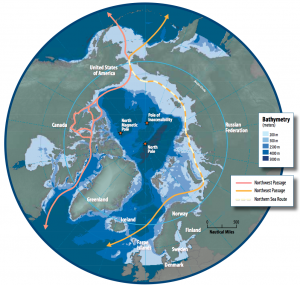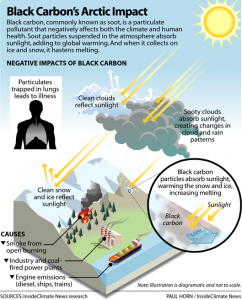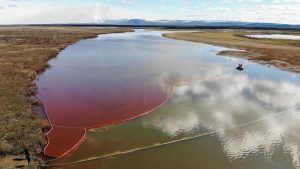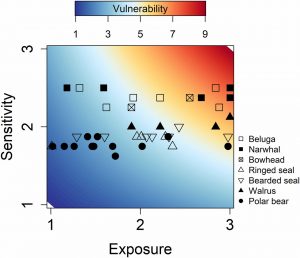Getting to know Arctic Shipping Lanes
The advent of climate change has brought about a number of different changes in the Arctic, including increased accessibility to Arctic ports as well as the opening of new Arctic shipping lanes. With new trans-Arctic routes, including the Northern Sea Route (NSR) and the Northwest Passage (NWP), as well as newly built and refurbished ports from Russia.
 Historically, the Northwest Passage is a relatively recent discovery. The search for a “Northwest Passage” to reach the Far East began as early as the 15th century with European settlers exploring the region. The first successful expedition was not until 1906 when Roald Amundson was able to navigate the passage, spending three years traveling. The challenge of traversing the passage came with the thick ice covering it during most of the year, something that began to change with the warming climate of the 20th and 21st centuries.
Historically, the Northwest Passage is a relatively recent discovery. The search for a “Northwest Passage” to reach the Far East began as early as the 15th century with European settlers exploring the region. The first successful expedition was not until 1906 when Roald Amundson was able to navigate the passage, spending three years traveling. The challenge of traversing the passage came with the thick ice covering it during most of the year, something that began to change with the warming climate of the 20th and 21st centuries.
The first time the Northwest Passage was fully clear of ice since 1978 was the summer of 2007, with more openings in the following decade. This change has allowed for other types of ships to pass through, including large shipping vessels. The region has become a much-coveted shipping lane. As for cruise ships, the first successful transit came in 1984 with the MS Explorer, a small ship carrying 98 passengers (Stewart et al 2007). This began a new era of cruise ships, one that most recently peaked with the first large cruise ship passing through the passage in 2016 (Santana et al 2020). According to some statistics from 2015, more than 15% of traffic in the Northwest Passage is now passenger ship related, a number likely to grow in the future.
Navigability of previously inaccessible Arctic sea routes has also increased in conjunction with Arctic sea ice loss, sparking commercial interests in the development of more direct connections among global markets. Industry and government see the melting of sea ice as an opportunity for oil and gas extraction, mining, tourism.
Black Carbon and Melting Ice
 The most significant effect is that shipping activities will accelerate the melting of sea ice. During the summer–fall open-water season, the extent of September sea ice cover has retreated 14% per decade since 1979, and the duration of the open-water period has increased 5–10 wk. Shipping exhaust contributes to global warming and can affect the arctic environment through the emissions of greenhouse gasses and other substances, including what’s called black carbon or soot.
The most significant effect is that shipping activities will accelerate the melting of sea ice. During the summer–fall open-water season, the extent of September sea ice cover has retreated 14% per decade since 1979, and the duration of the open-water period has increased 5–10 wk. Shipping exhaust contributes to global warming and can affect the arctic environment through the emissions of greenhouse gasses and other substances, including what’s called black carbon or soot.
Black carbon is detrimental to the Arctic environment. It forms as a result of incomplete fuel combustion with CO2. It is usually short-lived in the atmosphere and decomposes after two weeks. However, in the Arctic region it has a significant impact because it settles on the ice. it absorbs heat from the sun, which helps to melt snow and warm the ocean. By 2030, it is estimated that the 4.5 gigatons of black carbon will be dumped in the Arctic, and it could increase the warming impact of their greenhouse gas emissions by 78 per cent.
Oil and Gas Spill
Shipping activities also bring the risk of oil or chemical spill within the arctic environment. Arctic environment is highly susceptible to harm from chemical pollutants because the extreme low temperatures of the landscape and waterways reduces the ability for many of them to evaporate. The recovery time for damaged Arctic flora and waterways also increases due to extreme meteorological factors.
These types of accidents would be extremely hard to clean up due to the remote nature of the Arctic and our insufficient knowledge about the arctic may also hamper a cleanup too. Many of the existing nautical charts for the arctic shoreline were last updated in the 1950s.

Use of Heavy Fuel Oil
Heavy Fuel OIl is the dirtiest type of marine fuel. It is an extremely toxic and viscous marine fuel that breaks down slowly, particularly in colder regions like the Arctic. The IMO’s (International Maritime Organization) Marine Environment Protection Committee moved to ban the use and carriage of heavy fuel oil (HFO) in the Arctic Ocean in February 2020. This ban is expected to decrease the black carbon emission in the Arctic and thus lowering the speed of sea ice melting. The legalisation of hfo ban came out exceptionally late because of the resistance from Russia. Antarctic has banned HFO use as early as 2011, even though no cargo moves in its turbulent waters.
While the ban would start to apply in July 2024, exemptions and waivers included in the draft text would allow some ships to use HFO until July 2029. Countries can exempt their own vessels within their domestic waters. Secondly, all double-hulled vessels – ships that have two layers of watertight hull – are also exempt from the ban until the middle of 2029. The exemption effectively means that Russian-flagged vessels traveling along the country’s Northern Sea Route (NSR), will be exempt from the ban for nearly another decade, where we have witnessed the most rapid growth of shipping volume over the past decade.
Marine Mammals
Arctic marine mammals are often considered to be most vulnerable to the rapid environmental changes in the region. surging ocean heat causing a burst of ocean plant growth and altered behavior of bowhead whales. Toxic emission from shipping such as sulfur will enter the food chain of arctic animals. Moreover, bowhead whales are also known to rely on low-frequency sound for communication, which may be disrupted by ship noises.
 In an assessment covering the entire Arctic, Some researchers from the University of Washington at Seattle, USA, compiled data on 80 subpopulations of seven marine mammal species endemic to the Arctic. They specifically focused the analysis on the conditions now prevalent in September, when the ice coverage is at its minimum and most of the shipping activity occurs. Results would look different in the ice-covered season when fewer ships venture to the Arctic, but have to use icebreakers to get through. The investigation found that 42 of the 80 subpopulations studied were likely to become exposed to shipping traffic. Among these, the results were most dramatic in cases where species with traits making them sensitive to human impacts happen to have their habitat near the natural bottlenecks of the new shipping routes.
In an assessment covering the entire Arctic, Some researchers from the University of Washington at Seattle, USA, compiled data on 80 subpopulations of seven marine mammal species endemic to the Arctic. They specifically focused the analysis on the conditions now prevalent in September, when the ice coverage is at its minimum and most of the shipping activity occurs. Results would look different in the ice-covered season when fewer ships venture to the Arctic, but have to use icebreakers to get through. The investigation found that 42 of the 80 subpopulations studied were likely to become exposed to shipping traffic. Among these, the results were most dramatic in cases where species with traits making them sensitive to human impacts happen to have their habitat near the natural bottlenecks of the new shipping routes.
Conclusion
In addition to the problems mentioned early is the lack of research on this issue. It is a relatively new problem with cruising in the Northwest Passage only being possible for the last 35 years. It is also not an issue known to the general public, mainly due to the price being prohibitive to most individuals. Few of these cruises actually traverse the passage each year, further diminishing the urgency of the issue. Lastly, because the Arctic is still such a remote area, it is an issue not at the forefront of most people’s minds.
We have done some research about the policies to tackle issues brought by the arctic shipping activities. Sadly, many of them aren’t as effective as they are intended to be. If you want to know more about these policies and our opinions about them, please click go to next page.
- On this page, identify the shared themes and questions that link your research. Is one issue broader than the rest, or all they all parts of a related problem, or is one issue quite different? What is the most effective way for the reader to think about linking these issues together?
- Ask some questions to provoke the reader’s curiosity.
- Is there any background information about the Arctic that your reader might need to know? (Maps, general facts, etc.)
- What are the most important concepts or terms that reader might encounter? Introduce and define them here.
- Help the reader navigate the Arctic Issues and Policy Ideas tabs.
